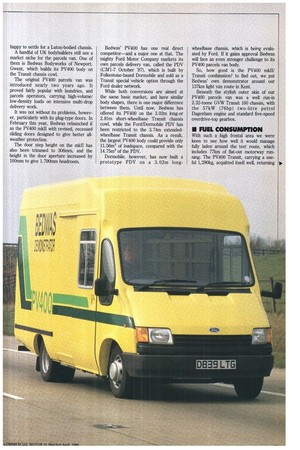ROADTEST BEDVVAS PARCELS VAN
Page 48

Page 49

If you've noticed an error in this article please click here to report it so we can fix it.
• The man at the weighbridge hit the nail smack on the head: "Do they still call these parcel vans?" he asked, eyeing up our green-and-yellow Bedwas-bodied Transit — "only you don't see too many of them around these days." He was right of course, although their decline in popularity is no great mystery.
Most manufacturers now offer factoryfitted high roofs on their long-wheelbase vans, so there simply isn't any need for custom-built parcels vans. The cavernous, 12.77m3 capacity of the long-wheelbase, high-roof Renault Master and the recently introduced Transit extra-high-roof option — which provides more than 1.82m of headroom and 10.1m3 of load space — are cases in point.
There is another factor in the equation: Luton-body manufacturers in recent years have taken a long, hard look at the relatively poor aerodynamics of their products and have built Luton bodies which have significantly reduced the gap in fuel economy between Luton-bodied chassis cabs and those with smoother, integral parcels van bodywork. As a result, many operators who need the volume, are now happy to settle for a Luton-bodied chassis.
A handful of UK bodybuilders still see a market niche for the parcels van. One of them is Bedwas Bodyworks of Newport, Gwent, which builds its PV400 body on the Transit chassis cowl.
The original PV400 parcels van was introduced nearly two years ago. It proved fairly popular with laundries, and parcels operators, carrying high-volume/ low-density loads on intensive multi-drop delivery work.
It was not without its problems, however, particularly with its plug-type doors. In February this year, Bedwas relaunched it as the PV400 mkII with revised, recessed sliding doors designed to give better allweather protection.
The door step height on the rnkII has also been trimmed to 306mm, and the height in the door aperture increased by 100nun to give 1.790mm headroom. Bedwas' PV400 has one real direct competitor—and a major one at that. The mighty Ford Motor Company markets its own parcels delivery van, called the PDV (CM1-7 October '87), which is built by Folkestone-based Dormobile and sold as a Transit special vehicle option through the Ford dealer network.
While both conversions are aimed at the same basic market, and have similar body shapes, there is one major difference between them. Until now, Bedwas has offered its PV400 on the 3.02m long-or 2.81m short-wheelbase Transit chassis cowl, while the Ford/Dormobile PDV has been restricted to the 3.74m extendedwheelbase Transit chassis. As a result, the largest PV400 body could provide only 11.56m3 of loadspace, compared with the 14.75m3 of the PDV.
Dormobile, however, has now built a prototype PDV on a 3.02m long
wheelbase chassis, which is being evaluated by Ford. If it gains approval Bedwas will face an even stronger challenge to its PV400 parcels van body.
So, how good is the PV400 mIdl/ Transit combination? to find out, we put Bedwas' own demonstrator around our 137km light van route in Kent.
Beneath the stylish outer skin of our PV400 parcels van was a well run-in 2.32-tonne GVW Transit 160 chassis, with the 57kW (76hp) two-litre petrol Dagenham engine and standard five-speed overdrive-top gearbox.
• FUEL CONSUMPTION
With such a high frontal area we were keen to see how well it would manage fully laden around the test route, which includes 77km of fiat-out motorway running. The PV400 Transit, carrying a useful 1,290kg, acquitted itself well, returning
















































































































































